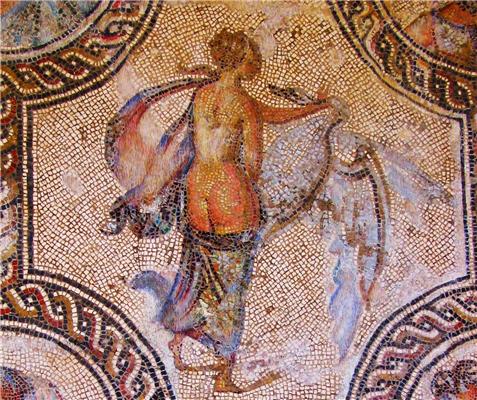Sometimes art isn't just art. Prior interpretations of Roman mosaics analyzed clothing as an iconographic element that was fundamental in identifying the characters and determining their status, but a new book centers on the opposite theme: the absence of any type of clothing.
“The construction of the bodies is neither natural nor casual, as we are sometimes led to believe, but rather it is the result of relationships based on power; they were well established in society and were promoted by those who wielded that power,” says UC3M Ancient History professor, Luz Neira.

Luz Neira/UC3M
Like all art historians, they find the distinction profound, and believe these representations of nudes goes beyond the study of the work of art, investigating the very significant ideological implications for the reconstruction of the history of the elite during the Roman Empire, and the level of its influence on posterity. The essays in the book “Desnudo y cultura: la construcción del cuerpo en los mosaicos romanos” (The Nude and Culture: the construction of the body in Roman Mosaics), coordinated and edited by Neira, notes that for women there is a subtle combination of different representations of the bust and abdomen, or the back and buttocks, which reflect care for the body and its availability; in contrast, they say that the nudes depicting male bodies, equally complete but muscular, show determination, strength and power
This asymmetric treatment of male and female bodies is therefore a reflection of relationships based on power, according to the researchers. Female figures predominate in mosaic scenes while the main male figures tend to be gods, heroes and mythological beings, or else wrestlers and athletes.
The mosaics were not limited to the most private areas of the homes, they were also in different receiving rooms of dwellings and in bathing areas, both public and private, where the impact of these images, sometimes covered by water. One very revealing example is a representation of Ariadne or the Nereid that shows a nude female figure lying on a marine animal, with one arm behind her head in a position and with a gesture that has been interpreted as “availability to the other.”
“The nudes chosen to decorate the flooring of domestic spaces are the result of the choices made by the most privileged members of the elite and they reflect their mentality, which leads us to consider that looking at them might awaken a series of feelings, reactions and attitudes,” notes Neira. “As is pointed out in the book, the reflected image is a tool for evocation, a symbol of everything that we see without really seeing and, at the same time, what we would like to see but do not see. Because the reflected image is, excuse the repetition, a reflection of the brain, the subconscious, the language of emotions,” she concludes.




Comments